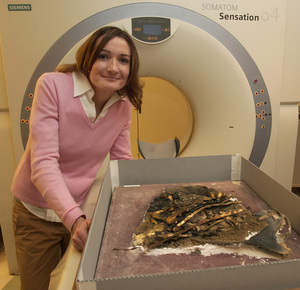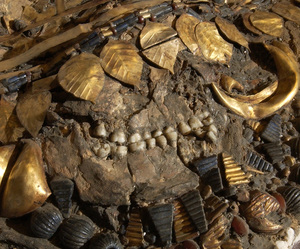
Posted on 04/17/2007 3:30:07 PM PDT by blam
Posted on Mon, Apr. 16, 2007
Death and the maidens
Penn researchers tackle Mesopotamian mystery.
By Tom Avril
Inquirer Staff Writer
Aubrey Baadsgaard says the ancient victims may not have walked into the Mesopotamian tomb and sacrificed and drank poison. She hopes CAT scans of two skulls yesterday will back up her doubts. JONATHAN WILSON / Inquirer Staff Photographer
Dozens of maidens, wearing headdresses of gold and lapis lazuli, walked down into a tomb in Mesopotamia 4,600 years ago. Each raised a cup to her lips, drank some poison, and lay down to die, hoping to join a king or other royal figure in the afterlife. It is an enduring tale from one of archaeology's most famous excavations, pieced together in the late 1920s after the discovery of several such "death pits" full of jewel-encrusted skeletons with clay cups at their sides.
Yesterday, Aubrey Baadsgaard set out to prove the story wrong.
Like some members of the team that dug up the remains nearly 80 years ago, she works at the University of Pennsylvania. But unlike them, she has access to the tools of modern science.
At 7 a.m., the skull from sacrificial maiden number 53 left its home at Penn's Museum of Archaeology and Anthropology.
Baadsgaard and other Penn scholars drove it across the street to the Hospital of the University of Pennsylvania, where it would receive a CAT scan - the first of several tests to determine who the young woman was, how she died and why.
Such scans are all the rage among museums with an Egyptian mummy or two. Tutankhamun's remains have undergone the procedure, as has an anonymous Ptolemaic mummy at Philadelphia's Academy of Natural Sciences.
But yesterday's scan of the Mesopotamian maiden is part of a massive effort at Penn, funded by $250,000 from the National Science Foundation.
Researchers are taking high-resolution, three-dimensional images of the university's entire historic collection of human and primate remains - roughly 10,000 skulls in all, some with other bones still attached. The images can then be sent around the world for study while the skulls remain safely on a shelf.
"We want to create a virtual museum," said Janet Monge, the Penn museum's acting curator of physical anthropology.
Baadsgaard's project, which includes the maiden and a helmeted soldier also scanned yesterday, is both scholarship and detective work.
The graduate student and her adviser, Penn professor Richard Zettler, believe the maiden and her 73 companions in the pit - most of them women - were indeed part of a mass sacrifice. But there has never been direct evidence of poisoning in the pit, and cups have been found in other tombs with no suggestion of sacrifice. Rather, Baadsgaard and Zettler suspect that the women were killed above ground, mummified in some primitive fashion, then carried down into the tomb. It is unclear whether the women were willing participants.
The scientists also hope to flesh out a theory by a University of Wisconsin scholar that the victims were not native to the area, but were brought from hundreds of miles away in what is today Pakistan.
It is tricky work. Both skulls were flattened during their long-ago burial and are caked with ancient dirt. But with a CAT scan - which uses X-rays to create three-dimensional pictures, one wafer-thin slice at a time - the two heads began to reveal their secrets.
First came the maiden.
Hospital technologist Scott Steingall pushed a button, and her skull moved slowly into the white, doughnut-shaped scanning device. An image appeared on the screen.
The woman's golden headdress and other jewelry obscured some of the bone fragments, as the radiation did not penetrate the metal. But Baadsgaard quickly spotted one thing she was after: the teeth.
She and Monge looked for a tooth that could be removed easily without damaging the artifact, with two goals in mind:
Some genetic material may be left in the tooth's inner chamber that once held fleshy pulp. If so, her DNA can be tested.
In addition, the tooth would be sent to Wisconsin, where scientists hope to discern the woman's diet by studying levels of various strontium isotopes in her enamel. If she and the other maidens did not eat Mesopotamian foods, that would support the theory that they were brought from far away.
Monge spotted one molar with a shallow root hole, which meant it might easily be extracted once she drills into the mass of hardened earth and bone.
"Basically, this person had periodontal disease," Monge said. "That'll help us out."
They also looked for another bone fragment that could be removed and analyzed for signs of heating, a form of mummification thought to have been used in other burials from the period. That would suggest the person was killed and subjected to a drying process for preservation - and only then carried into the pit.
Finding a cause of death will be tough. The bones are not likely to retain evidence of poison. And the original excavators did not save the cups, so they can't be tested for toxic residue.
The skull may show evidence of a fatal blow. But the gold obscuring the woman's skull will make it difficult to construct a 3-D model.
Still, it was clearly a thrill for Baadsgaard, who got the itch to study archaeology after seeing Native American artifacts as a child in Utah.
She watched as the soldier's skull took its turn on the scanner. That image was even better. Though he wore the remains of a copper-alloy helmet, the metal had largely become mineralized and did not shield the underlying bone fragments.
"Can you see the bone under the . . . " Baadsgaard began, then gasped. "Wow, you can. That's amazing."
If she gets approval from a museum committee, Baadsgaard will proceed with the next round of tests this year.
Penn has scanned 2,000 of its human skulls so far. At first, the hospital's radiology department charged the anthropologists about $100 per scan. Once it saw the value of the project, the department lowered the price to less than one-tenth that, charging only for the staff time.
Yesterday was the first such scan for the hospital's Steingall, who is used to live patients.
"It's like watching the Discovery Channel in person," he said.
Steingall was mystified by the notion of courtiers following their kings and queens to the grave.
"So if you were with the king, you went with him?" he asked.
"They presumably thought there was an afterlife, and you were joining the king," explained the University of Michigan's Tom Schoenemann, who codirects the scanning project with Monge.
The tombs were an international sensation when discovered. At first Leonard Woolley, head of the joint expedition by Penn and the British Museum, took pains to keep the find under wraps.
When he reported back to his collaborators in Philadelphia, he sent them a telegram in Latin to keep the message secret.
The finds were split among Penn, the British Museum, and the fledgling nation of Iraq, giving scholars a wealth of clues about the area known as the cradle of civilization.
But 80 years later, it seems, the full story of the sacrificial victims remains to be told.

Interesting ping
Let me see ya grillz, yea yea ya grillz!
(Ancient Egypt)??
Mesopotamia isn't Egypt. Wrong continent, for one thing.
Yup. You are correct, I have no idea what I was thinking.




Sorry Blam, meant to ping you.
LOL!
Nice .gifs!
/E/
I xould use a few drinks tonight!
- I see “Egypt” was pulled from thread title
- So my “really tall & steep” pyramid does not fit!

Ziggurant
No drinks from the poisoned pitcher, lol. Out of beer, huh?
[Mesopotamia refers to the region now occupied by modern Iraq, eastern Syria, southeastern Turkey, and Southwest Iran]
Had to look it up to be certain. Looks like my little Egyptians need to move to another thread, lol. Maybe one with ‘Cool-Ade’ drinkers.
An ancient advanced area now living in the past -
Hey, They devolved!!
[that was the worst meaning of the word, as you well know]
LOL!
Exactly!
That was never a peaceful area
Hmmmm, WHY did you pick that name, lol?
Please FREEPMAIL me if you want on or off the
"Gods, Graves, Glyphs" PING list or GGG weekly digest
-- Archaeology/Anthropology/Ancient Cultures/Artifacts/Antiquities, etc.
Gods, Graves, Glyphs (alpha order)
I don't care what you needed for a master's thesis,
NO healthy person is or was going to skip happily into a tomb, drink poison, and look forward to joining their 'master' in an afterlife!

In the year 1922, an archaeologist by the name of C. Leonard Woolley unearthed interesting discoveries in the ancient Sumerian city of Ur. He unveiled 1800 graves and among them 16 tombs caught especially his attention. They were named "The Royal Tombs of Ur" after the treasures found. One of the artifacts recovered from the tombs was the famous gold and lapis lazuli bull's head lyre. Beneath the bull's head is an inlaid plaque portraying mythical animals drinking and performing. Another great find was the statue Wooley liked to call "ram caught in a thicket". The statue is made of gold, silver, lapis lazuli, copper, shell, red linestome, and bitumen. However, the tomb of Queen Puabi, and the artifacts found in her tomb were the most extraordinary. It's not just because of its richness but because it also survived through years of looting. With Queen Puabi was her intricate headdress.It was made of gold leaves, ribbons, strands of lapis lazuli, and carnelian beads. She also had a comb made out of gold, chokers, necklaces, and a pair of moon-shaped earrings. The treasures of the Tombs of Ur will remain in History as one of the most impressive cultural heritage of the Middle East. Today, the artifacts can be found at the University of Pennsylvania Museum of Archaeology and Anthropology.
Source: McClung Museum Special Exhibition Image: Ur, Photograph 17th January 2004, by Lasse Jensen. The Royal tombs.
Disclaimer: Opinions posted on Free Republic are those of the individual posters and do not necessarily represent the opinion of Free Republic or its management. All materials posted herein are protected by copyright law and the exemption for fair use of copyrighted works.